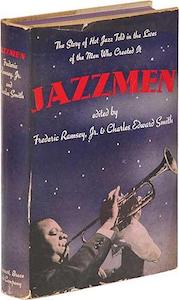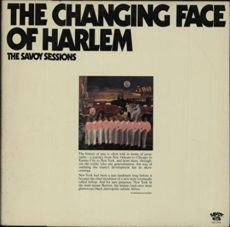
Daily Dose Of Jazz…
Charles Edward Smith was born on June 8, 1904 in Thomaston, Connecticut He began to collect early hot jazz records in the 1920s and worked with William Russell, Eugene Williams, John Hammond, Hugues Panassié and Charles Delaunay in the Hot Record Society. It was from this society that the jazz label HRS Records sprang in 1937 and with Steve Smith he was editor of the jazz magazine Hot Record Society Rag.
With essays in journals such as the Symposium, Daily Worker and Esquire, Charles was among the early jazz critics in the 1930s. Collaborating with Frederic Ramsey he published the book Jazzmen, and, with Wilder Hobson’s American Jazz Music, was one of America’s first jazz books. The latter book included articles on groups like the Austin High School Gang and interviews from early jazz musicians like Willie Cornish, Papa Jack Laine, Leon Roppolo and Nick LaRocca.
Smith and Ramsey argued that then-popular swing was rooted stylistically in blues and traditional jazz. In the course of the research on the book, the interviewed musicians mentioned the name Bunk Johnson again and again. This led to the then-forgotten trumpeter of New Orleans Jazz being rediscovered by Bill Russell in 1942.
With the 1942 Jazz Record Book, an attempt was made to generate a canon of important jazz records, which was later taken up by many other writers, including Marshall Stearns’s The Story of Jazz, Joachim-Ernst Berendt/Günther Huesmann’s jazz book , Barry Kernfeld’s Encyclopedia of Jazz, and Allen Lowe’s That Devilin’ Tune.
Smith also wrote for The New Republic, the magazine Jazz Information, and wrote a series of liner notes for Folkways Records that included Negro folk music, folk blues, early and modern jazz albums. He also wrote the accompaniment text for the LP edition of John Hammond’s Concert Series, From Spirituals to Swing – Carnegie Hall Concerts, 1938/39 on Vanguard Records.
In the opinion of the International Society of Jazz Research, Smith was one of the most important early serious jazz critics, alongside Hugues Panassié, Winthrop Sargeant, Wilder Hobson, Don Knowlton, and Aaron Copland. Jazz author, editor and critic Charles Edward Smith transitioned on December 16, 1970 in New York City.
More Posts: author,critic,editor,history,instrumental,jazz,music

Daily Dose Of Jazz…
Dan Morgenstern was born October 24, 1929 in Munich, Germany and was raised in Vienna, Austria and Copenhagen, Netherlands before arriving in the United States in 1947. He wrote for Jazz Journal from 1958–1961, then edited several jazz magazines: Metronome in 1961, Jazz from 1962–1963, and Down Beat from 1967-1973.
In 1976, he was named director of Rutgers–Newark’s Institute of Jazz Studies, where he continued the work of Marshall Stearns and made the Institute the world’s largest collection of jazz documents, recordings, and memorabilia.
Over the course of his career, Morgenstern has arranged concerts including the Jazz in the Garden series at the Museum of Modern Art, produced and hosted television and radio programs, taught jazz history at universities and conservatories, and served as a panelist for jazz festivals and awards across the U.S. and Europe.
Widely known as a prolific writer of comprehensive, authoritative liner notes, he has received eight Grammy Awards for Best Album Notes since 1973 for Art Tatum’s God Is in the House, Coleman Hawkins’ The Hawk Flies, Savoy Records Collection The Changing Face of Harlem, Erroll Garner: Master of the Keyboard, Clifford Brown, Brownie: The Complete Emarcy Recordings of Clifford Brown, Louis Armstrong, Portrait of the Artist as a Young Man, Fats Waller, If You Got to Ask, You Ain’t Got It!, and The Complete Louis Armstrong Decca Sessions.
He has authored two books that have won ASCAP’s Deems Taylor Award: Jazz People in 1976 and Living with Jazz in 2004. In 2007, he received the A.B. Spellman Jazz Masters Award for Jazz Advocacy from the National Endowment for the Arts. Writer, editor, archivist and producer Dan Morgenstern continues his career at 87 years of age.

Daily Dose Of Jazz…
George Thomas Simon was born on May 9, 1912 in New York City into a wealthy and talented family, with his brother co-founding the publishing house Simon & Schuster and also his niece, singer Carly Simon. He began as a drummer and was an early drummer in Glenn Miller’s orchestra.
After graduating from Harvard University in 1934 he began working for the Metronome magazine the following year, then became editor-in-chief from 1939 to 1955and shifted it, from writing technical articles, to being a chronicler of the swing era. Simon was probably the most influential jazz commentator during the swing era and with his inside connections in the jazz world, he was able to report information about bands and their personnel with great accuracy.
Leaving Metronome he went to the Jazztone Society, consulted for the Timex Jazz Shows, wrote about jazz for the New York Herald Tribune and the New York Post newspapers. He also did liner notes for a variety of jazz musicians including Thelonious Monk who was stylistically quite different from the swing-era musicians Simon championed.
In 1978, he won a Grammy Award for Best Album Notes, was inducted into the Big Band and Jazz Hall of Fame and on February 13, 2001 after years of suffering from Parkinson’s disease, he died of pneumonia in New York City.
More Posts: commentator,editor,writer




